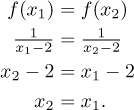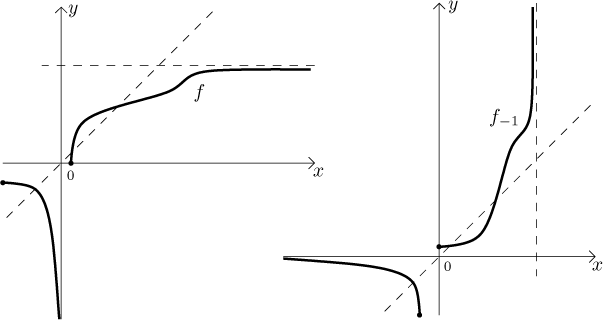
There are two basic methods for deciding whether a function f is 1-1.
By definition. Start with the equation
Using theory. There are several theorems that guarantee that a function is 1-1. Probably the easiest and at the same time very useful is this:
If a function is strictly monotone on a set, then it must be 1-1.
In particular, if a function is continuous on an interval I, differentiable on its interior, the derivative is never zero and has the same sign on this interior, then the function is 1-1 on I.
Once we have a function that is 1-1 somewhere, we can find its inverse by
solving the equation
Example: Decide whether the function
Solution: First we will show that this function is 1-1. Since it looks simple, we try it by definition.

Since all the steps were equivalent, there is really only the one solution and the function is therefore 1-1.
Note that if we tried the theory way, we would have a problem. The domain of
this function is
Anyway, we have a function that is 1-1 on its domain and now we want to find its inverse:

If we wanted to work just with the inverse function without relation to the original f, we would not need to be reminded of the setup by the variable y, it could be more convenient to relabel the variable to the usual x:
![]()
Important properties:
1. The domain and range exchange places:
2.
The graph of the inverse function can be obtained by taking the graph of
f and flipping it around the main diagonal
Example: On the left we show the graph of some 1-1 function f, on the right its inverse.

For more examples see Solved problems.
Transformations, graph guessing
Back to Methods Survey - Basic
properties of real functions